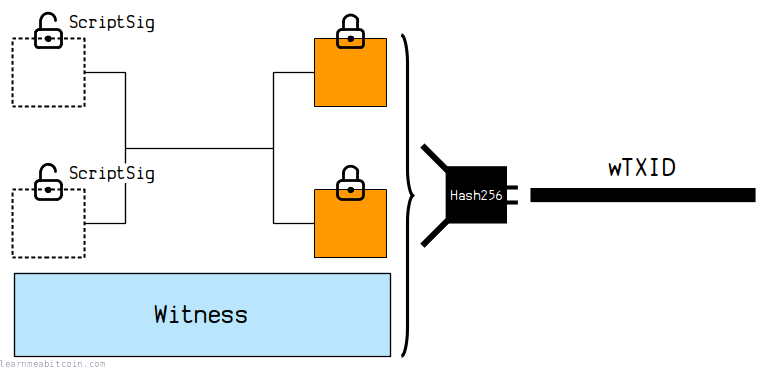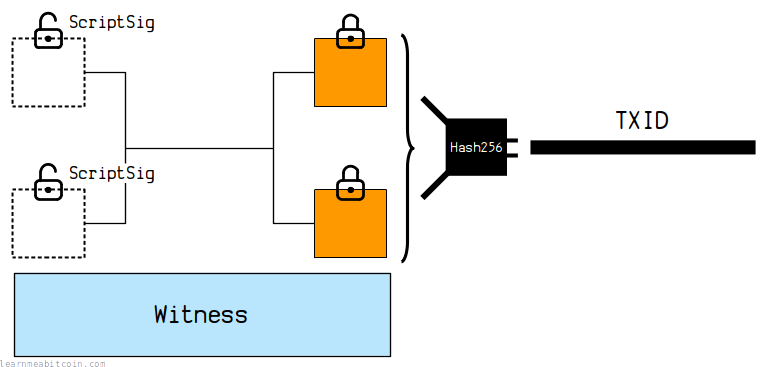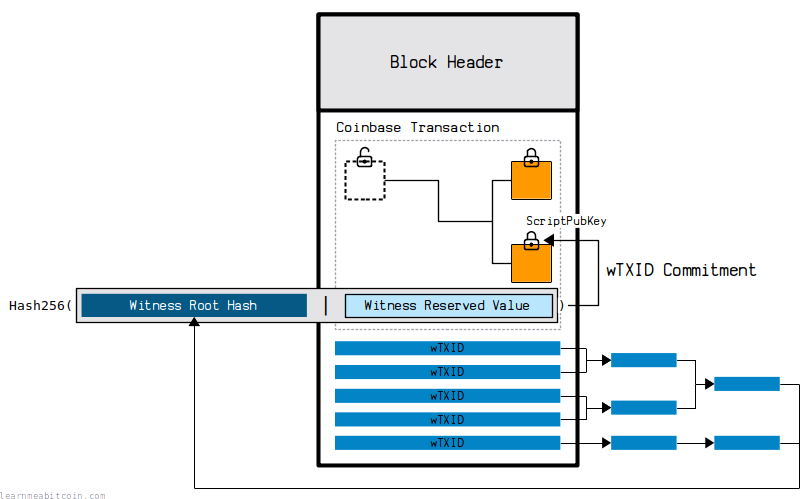wTXID
TXID with witness data
A wTXID is like a TXID, but a wTXID includes the witness data of a transaction.
For example:
A wTXID is the HASH256 of all of the transaction data, including the marker, flag, and witness:

Whereas a TXID is the HASH256 of all of the transaction data except the marker, flag, and witness:

The diagrams above do not show the marker and flag fields.
Examples
How do you create a wTXID?
From a technical perspective, a wTXID is calculated by hashing the following fields of a serialized raw transaction:
wTXID = HASH256([version][marker][flag][inputs][outputs][witness][locktime])Segwit Transaction
Here's the raw transaction data for a segwit transaction. I've highlighted the new segwit fields:
01000000000101438afdb24e414d54cc4a17a95f3d40be90d23dfeeb07a48e9e782178efddd8890100000000fdffffff020db9a60000000000160014b549d227c9edd758288112fe3573c1f85240166880a81201000000001976a914ae28f233464e6da03c052155119a413d13f3380188ac024730440220200254b765f25126334b8de16ee4badf57315c047243942340c16cffd9b11196022074a9476633f093f229456ad904a9d97e26c271fc4f01d0501dec008e4aae71c2012102c37a3c5b21a5991d3d7b1e203be195be07104a1a19e5c2ed82329a56b431213000000000The TXID is the HASH256 of all of the transaction data except the marker, flag, and witness:
The wTXID is then just the HASH256 of all of the transaction data including the marker, flag, and witness:
f12d56f2234e809129dbf59392961bbe7a89b6250651f6aea7852cc00ced63ff
You can check this for yourself by putting the data through HASH256 manually:
Byte Order. Don't forget that TXIDs and wTXIDs are displayed in reverse byte order, so the initial result of the HASH256 will be in natural byte order (which means that the result looks backwards at first).
Legacy Transaction
A non-segwit transaction will have the same TXID and wTXID.
For example, here's the raw transaction data for a legacy transaction:
0100000001ba1e48633efb7397536c3b45582cb763b1903b1364865f6de0f53387d306c87d010000006b483045022100df50e78ee42725165eceed6e6e1c534936015d3ef9e410d301de682a3655012f02203d21199bc19d982926fcf6bfe26773f4a0b2befdabb742542469f04e739764cb012103668b0f35effa223f001fb1c39d61bde513d5c6291b84227e84fd3e7daf0e3a6afeffffff02ce6d6002000000001976a9144ccb1bfd0099bf5ba2e2799a9f444f9583a74ce088ac35102408000000001976a914e5555373c7d95bb6a2cfcf7e9ffb3fcb5a305ba988ac711a0600This is the TXID:
And seeing as a legacy transaction does not include a marker, flag, or witness, it will have the same wTXID:
25346687d5d10239c25a88193c97228327826a4ff66a36c4ba7e038f3e2ae9ed
You can find the wTXID of a transaction by running bitcoin-cli getrawtransaction <txid> 1. The wTXID will be equal to the "hash" field, as this "hash" is the HASH256 of the entire transaction data (in reverse byte order), which is currently equal to the wTXID.
wTXID Commitment
Committing transaction witness data to the block

wTXIDs are used to commit the new data in segwit transactions to the block via a witness root hash.
Commitments are used to bind a party to a value so that they cannot adapt to other messages in order to gain some kind of inappropriate advantage.
For example, all of the legacy transaction data is committed to the block header by creating a merkle root of all the TXIDs in the block.
However, the TXIDs do not include the marker, flag, and witness data. So for all blocks since the Segregated Witness upgrade, we also create a merkle root for all of the wTXIDs, and commit that to the block by creating a witness root hash.
This witness root hash gets HASH256'd with the witness reserved value to create a wTXID commitment. This gets placed inside the ScriptPubKey of one of the outputs of the coinbase transaction.
So now there is a commitment for all the new segwit transaction data placed inside the block. So if anyone tries to change the contents of the witness data in any of the transactions in the block, it will not match the wTXID commitment and the block will be invalid.
wTXIDs are ultimately used to prevent anyone from editing the new segregated witness transaction data included in the block.
Example
The block at height 553,724 contains the following 4 transactions:
The first three are segwit transactions, so they contain witness data that will not be committed to the block header via their TXIDs alone.
These are the wTXIDs for each of the transactions:
0000000000000000000000000000000000000000000000000000000000000000
8700d546b39e1a0faf34c98067356206db50fdef24e2f70b431006c59d548ea2
c54bab5960d3a416c40464fa67af1ddeb63a2ce60a0b3c36f11896ef26cbcb87
e51de361009ef955f182922647622f9662d1a77ca87c4eb2fd7996b2fe0d7785
When calculating the witness root hash, the wTXID for the coinbase transaction must be set to all zeros. This is because it's eventually going to contain the commitment inside it, so this avoids a circular reference.
The last transaction is a non-segwit transaction, so its wTXID is the same as its TXID.
If we create a merkle root from all of these wTXIDs we get the witness root hash:
witness root hash: dbee9a868a8caa2a1ddf683af1642a88dfb7ac7ce3ecb5d043586811a41fdbf2
Now if we look inside the input of the coinbase transaction we find the witness reserved value:
witness reserved value: 0000000000000000000000000000000000000000000000000000000000000000
Finally, if we concatenate and HASH256 the witness root hash and witness reserved value, we get the wTXID commitment:
wTXID commitment = HASH256(witness root hash | witness reserved value)
wTXID commitment = 6502e8637ba29cd8a820021915339c7341223d571e5e8d66edd83786d387e715
This wTXID commitment gets placed in the ScriptPubKey of one of the outputs in the coinbase transaction. So if we check the ScriptPubKey of output 1 of the coinbase transaction for this block we find the following script:
OP_PUSHBYTES_36
aa21a9ed6502e8637ba29cd8a820021915339c7341223d571e5e8d66edd83786d387e715
You'll see that the wTXID commitment is contained within the last 32 bytes of that data push.
- The first 4 bytes
aa21a9edis just a fixed header used to identify that this output contains the wTXID commitment. - The next 32 bytes
6502e8637ba29cd8a820021915339c7341223d571e5e8d66edd83786d387e715is the same wTXID commitment we have just calculated.
All coinbase transactions since the segregated witness upgrade must include this commitment to the witness data. They all have to include an output with this script pattern: starting with OP_RETURN, followed by a OP_PUSHBYTES_36 that contains a 4-byte header followed by the 32-byte wTXID commitment.
The wTXID commitment can be contained inside any of the outputs of the coinbase transaction. If there are multiple outputs with this structure for some reason, the highest output index number that contains this wTXID commitment structure will be taken as the commitment.
Usage
How are wTXIDs used in Bitcoin?
wTXIDs are only used internally in Bitcoin to create a commitment for the new segwit fields of transactions.
The wtxid is only used to compute the Witness merkle root, which is committed to in the coinbase.
So you wouldn't use the wTXID to look up a transaction in the blockchain or anything like that.
You still use the TXID to look up transactions in the blockchain. A TXID is still a unique identifier of a transaction, as it still hashes the effect of a transaction (moving coins from existing outputs to new outputs), which is always unique to each transaction. The witness data is only important for transaction validation (unlocking the inputs), and this does not make the transaction data any more unique than it already is.
Signatures inside a transaction actually don't describe the effect of a transaction. A transaction moves coins around, reassigns them. But the signature is only there to prove that the transaction was authorized, it doesn't change its effect.